7.7 The High Renaissance
Vasari’s 3rd Stage of the Renaissance: Leonardo and Michelangelo
By the latter half of the 15th Century, the new techniques and styles of the Renaissance era were maturing. Humanist themes were well established. The commitment to mimetic Illusionism was firm. The linear perspective craze had settled into a core component of the craft that required no self-conscious exaggeration. Sculptors had studied remnants of Greek and Roman statuary and were emulating contrapposto and other effects. The foundation was there for transcendent achievement.
Leonardo
A “Renaissance Man” is blessed with many gifts and achieves in a variety of cultural fields. It derives from the fact that wealthy patrons expected an artist in their employ to be ready to paint, sculpt, plan buildings, design costumes for masques, and more. One Renaissance man reigned supreme: Leonardo da Vinci.
One of the most diversely creative people in human history, Leonardo really did everything, much of it in his mind. He was one of the pre-eminent anatomists of his day, dissecting cadavers to enhance the mimetic accuracy of his sculpture and painting. He sent a letter to the Borgias volunteering to invent new war machines, including helicopters and tanks. Throughout his life, Leonardo sought new designs and techniques, not only for art, but for technology:
Leonardo’s notebooks remained obscure for centuries, in part because he wrote text backwards, a mirror image. However, his now famous sketch of Vitruvian Man shows a mathematical interest in proportion reminiscent of the Greek ideal.
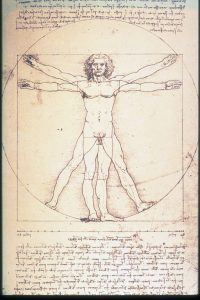 |
| Vitruvian Man (1492). Pen, ink, watercolor, paper. |
Leonardo’s Evolving technique
In Leonardo’s paintings, we can see Renaissance techniques reach maturity. Compared to Annunciations of earlier masters, his 1472 composition achieves supreme precision in Linear Perspective, Foreshortening, and Mimesis. Figures and objects are deftly modeled and the lines leading to the Vanishing Point precisely calculated. Even the angel’s wings seem to match the anatomical structure of a bird. And yet, the whole seems a bit forced. That Linear Perspective reaches back further than necessary. The composition masters the preoccupations of the day, perhaps a bit more than is needed.
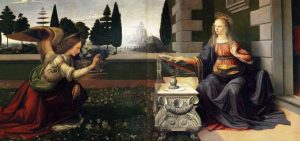 |
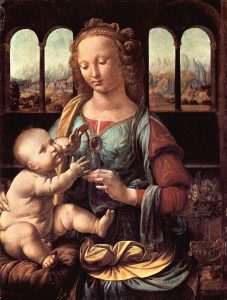 |
| Annunciation. (1472). Oil on panel. | Madonna of the Carnation. (1478). Oil on canvas. |
Dated just six years later, the Madonna of the Carnation achieves an organic unity. The subject is ostensibly Madonna and Child, but the treatment is wholly natural, essentially a portrait of a specific woman, dressed in the latest sumptuous fashions, and her child residing in a well-appointed chamber. A window in the back wall opens out onto a specific landscape of hills. The Italian word for window—Veduta—was used to label this convention in Renaissance portraits set inside a room. The figures are meticulously modeled, but the painter feels no need to shove extraneous architectural lines into the composition merely for the sake of linear perspective.
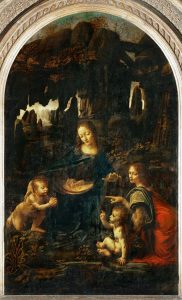 |
| Virgin of the Rocks. (1508). Oil on panel, transferred to canvas. |
Thirty years later, a mature Leonardo composed his Virgin of the Rocks, a remarkable exercise in Organic Form and composition. Leonardo’s taste for natural appearance led him away from geometrically precise compositional lines and forms. Here, a dizzying array of organically shaped, forbidding rocks surround the Holy Family and lead our eyes beneath their menacing shadows and out to sea. If we zero in on the figures of the family, we see a loosely triangular grouping with Eyelines forming an implied ring of intimacy.
The Mona Lisa
Of course, Leonardo is most famous today for the small portrait—about 30 by 21 inches—that we know as the Mona Lisa, perhaps the most famous painting in the world. But what makes it so special as a painting?
It is difficult to get a sense of the painting’s textures without standing before it. And a good look is hard to achieve. The salon in which the canvas hangs throngs with visitors seeking a glimpse of the world’s most famous painting.
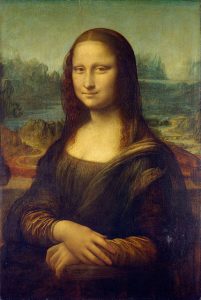 |
| Mona Lisa. (1503-1506). Oil on panel. |
Everyone speaks of that enigmatic smile, and we wonder what the woman is thinking. The woman’s eyes look directly “into the camera,” so to speak, opening mysterious portals into an elusive inner character.
A mature Leonardo richly demonstrated the rich possibilities of oil paint. The Mona Lisa reveals impossibly rich Textures, subtle layers of light, shadow, and color. The brushwork is sublime, blending the textures of the woman and of the atmospheric background into a seamless, organic whole without artificially etched contours. Leonardo himself supplied the name for a hugely influential technique:
European painters of the next 400 years would strive to “melt” their brushwork into the organic textures of the subject, all but erasing the traces of the medium.
Michelangelo’s Christian Humanism
The complex commitments and orientations of Christian Humanism find their highest expression in the great sculptor and painter Michelangelo Buonarotti. Michelangelo considered himself primarily a sculptor, and his compositions display his close study of Classical statues on display in Florence and Rome. Like Leonardo, Michelangelo attended autopsies to gain an intimate knowledge of the human body. Like Classical sculptors, he envisioned ideal, perfect human forms. Yet his subjects were almost always Christian.
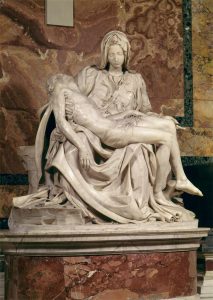 |
 |
| Pietà. (1498-1500). Marble. | Moses. (1515). Marble. |
Michelangelo’s Pieta is one of thousands of examples of the genre that honored the moment of Mary’s greatest grief. But the composition and execution of his version are stunning. The anatomies of the figures, the drapery of Mary’s robes, the lifeless drooping of Christ’s body, the textures of soft flesh are sublimely rendered. Notice how the living woman holds her body’s weight while the limbs of Jesus’ body hang loose and lifeless. Michelangelo adapts the finest Classical technique to a composition conceived in Christian terms.
Michelangelo carved his David for the roof of the Duomo (Cathedral) in Florence. But the people of Florence loved it so much that it was placed in the Palazzo Vecchio, the city’s central public square. We find again the principles of Greek sculpture: meticulous anatomy, Contrapposto (uneven distribution of weight on the legs) and ethos (character): the calm, confident gaze of a masterful, born leader.
 |
 |
|
| David. (1504). Front view. Marble. | Jörg Bittner Unna. (July 21, 2021). Michelangelo’s David( 1504). Side view. Photograph. | Unna’s David. (1504). Detail. . |
Of course, this David wears no clothes. Nudes had been unknown in Christianized Europe for nearly 1,000 years. But, embodying the rebirth of Greek classicism, Michelangelo’s predecessor, Donatello, shocked the Renaissance art world when his David wore a floral hat and nothing else. For Michelangelo, the representation of David in the nude was an act of piety. Humanist thought of the day saw human beings as the pinnacle of God’s creation. Michelangelo followed Greek masters in depicting the male nude as the Greek ideal of the human form.
 |
 |
| Creation of Adam. (1508-1512). Fresco. | Creation of Adam. (1508-1512). Detail |
For me, the ultimate Christian humanist image is found in Michelangelo’s painting. In 1505, the sculptor was called upon to paint frescoes on the walls and ceiling of the Sistine Chapel in the Vatican. Though not primarily a painter, Michelangelo labored for seven years over hundreds of Biblical figures in dramatic action. The crowning glory of the room is the highest panel of the ceiling, Michelangelo’s depiction of God breathing life into the stirring Adam, in Christian Humanist thinking, God’s greatest creation. Christian humanists of any age may in this image find inspiration for openness to human culture in the context of faith.
Vital Questions
Context
The High Renaissance formed the pinnacle of achievement for Christian humanism. Things would become complicated soon after the dawn of the 16th Century, not least through the outbreak of religious conflict during the Protestant Reformation. For a time, in the work of Leonardo, Michelangelo, and Raphael Classical and Christian traditions fused in palpable harmony.
Content
Leonardo and Michelangelo shared the fascination of earlier Renaissance artists in the task of rendering an authentic imitation of vision: the components of a moment in time and space. Whether composing a portrait or a biblical scene, their commitment was to the realistic structure and details of what we actually see. At the same time, a good deal of Classical idealism illuminated their compositions. Michelangelo especially sought the ideals of human form in his figures.
Form
Leonardo and Michelangelo also shared their predecessors’ commitment to Illusionism: the responsibility to imitate the appearance of nature as naturalistically as possible. Leonardo drew on developments in oil paint, perspective, and anatomy. Michelangelo emulated the technique of Classical sculptors. In many ways, artists have been trying to catch up ever since.
References
BBC. (2014). Leonardo da Vinci (1452 -1519) [Article]. BBC History. http://www.bbc.co.uk/history/historic_figures/da_vinci_leonardo.shtml
Chiaroscuro, Tenebrism, and Sfumato [Article]. (N.D.). The Art Story: Your Guide to Visual Art. https://www.theartstory.org/definition/chiaroscuro-tenebrism-sfumato/history-and-concepts/
Leonardo da Vinci. (1472). Annunciation [Painting]. Florence: Uffizi Gallery. https://www.uffizi.it/en/artworks/annunciation
Leonardo da Vinci. (1472). Lady with Ermine [Painting]. Cracow, PO: Czartorysky Museum, Mkrt https://www.wikiart.org/en/leonardo-da-vinci/the-lady-with-the-ermine-cecilia-gallerani-1496
Leonardo da Vinci (circa 1478). Madonna of the Carnation [Painting]. Munich: Alte Pinakothek. https://www.sammlung.pinakothek.de/en/artwork/Y0GR916LRX
Leonardo da Vinci. (1503-1506). Mona Lisa [Painting]. Paris: Musee du Louvre. INV 779; MR 316 https://collections.louvre.fr/en/ark:/53355/cl010062370
Leonardo da Vinci. (about 1508). The Virgin of the Rocks [Painting]. Paris: Musée du Louvre. INV 777. https://www.louvre.fr/en/oeuvre-notices/virgin-rocks
Leonardo da Vinci. (1492). Vitruvian Man [Illustration]. Venice, Italy: Gallerie dell’Accademia. Wikimedia https://commons.wikimedia.org/wiki/File:Vitruvian.jpg.
Michelangelo. (1508-1512). Creation of Adam [Fresco.] Rome (Vatican): Sistine Chapel. https://www.museivaticani.va/content/museivaticani/en/collezioni/musei/cappella-sistina/volta/storie-centrali/creazione-di-adamo.html
Michelangelo. (1501-1504). David [Statue]. Front View. Florence, IT: Galleria dell’Accademia.. https://www.galleriaaccademiafirenze.it/en/artworks/david-michelangelo/#
Michelangelo. (c 1515). Moses [Sculpture]. Rome, IT: Basilica of St. Peter in Chains. WikiArt https://www.wikiart.org/en/michelangelo/moses-1515
Michelangelo. (1498-1500). Pietà [Statue]. Vatican: St. Peter’s Basilica. https://www.museivaticani.va/content/museivaticani/en/eventi-e-novita/iniziative/Eventi/2022/tre-pieta-di-michelangelo.html
Unna, Jörg Bittner. (July 21, 2021). Michelangelo’s David, detail, side view [Photograph]. Wikimedia Commons https://commons.wikimedia.org/wiki/File:%27David%27_by_Michelangelo_FI_Acca_JBS_024.jpg.
the illusion of depth in a 2-dimensional image (e.g. a painting) in which contour or architectural lines angle toward a vanishing point
an illusion of depth created by contrasting the sizes of objects on the basis of how near or far they are from the eye of the viewer. E.g. a human figure in the foreground will be larger than a tall building in the distance.
a representational technique in visual art that strives to imitate as closely as possible the appearance of the “real thing”
in visual composition, a distant point at which lines converge, suggesting depth and a horizon. E.g. twin lines of a railroad track converging to create the illusion of distance
common in the Italian Renaissance, an interior portrait scene with a window in the back wall opening onto a landscape in the distance
in visual art, an irregular form such as a cloud or rocky terrain that suggests natural origin distinct from human artifice
an implied line defined by the direction stretching from the gaze of a figure in the scene
in visual art, the illusion of surface feel either of A) the represented object (e.g. textures of clothing) or B) of the artifact’s media (e.g. canvas weave, brushstrokes, daubs of paint)
A) a 14th Century shift in European culture from a narrow, exclusive focus on scripture and Church interests to a broader interest in cultural traditions, especially those of classical Egypt, Greece and Persia. B) a perspective that values and focuses on the capacities of human beings for knowledge, wisdom, and creativity.
A) an aesthetic valuing clarity, order, balance, unity, symmetry, and dignity, usually honoring a cultural tradition associated with some golden age of the past. B) in the Euro-American tradition, a reference to the works, styles, and themes of Greek and Roman antiquity.
a particular type of composition marked by expected, conventional features: e.g. Japanese haiku, Chinese landscape painting, Renaissance sonnet
a mimetic technique characteristic of Classical Greek sculpture which emulates the muscular exertions and unequal distribution of weight that characterize the way that human beings actually stand
the conviction that a painting or sculpture’s most important task is to imitate the appearance of nature as naturalistically as possible
crucial to the development of art during the European Renaissance, a paint medium that suspends and fixes pigment in a base of linseed or other oil. Oil paint dries slowly and can be worked, reworked, and applied in layers, thus permitting the buildup of subtle, complex visual effects
in visual art, the illusion of 3-dimensional forms and spaces in 2-dimensional compositions by aligning and scaling forms to suggest depth and distance.
